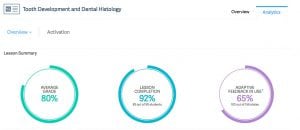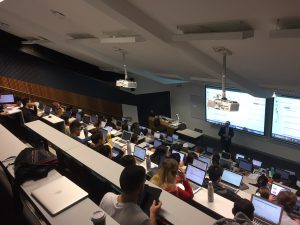Professor Hans Zoellner and Dr Babak Sarrafpour from the School of Dentistry were recipients of an Educational Innovation grant this year to improve student engagement in Oral Pathobiology. The EI health team has been working with them to implement a new teaching approach to improve student engagement.
Oral Pathobiology is taught through the use of Clinico Pathological Enquiry Based Learning Sessions (CPEBLS). These sessions had previously been taught using paper-based cases comprising:
- an introductory lecture;
- completion of paper-based exercise sheets (approx. 15 pages), with students accessing answers from texts, and interpreting relevant images based on their learning; and
- a concluding face-to-face review class.
Although the sessions were well attended, Dr Sarrafpour reported:
a significant proportion of students did not complete the written exercises, but instead attended reviews to simply harvest the answers
The EI grant was therefore to develop a ‘flipped’ approach to the sessions, using online eNotebooks to encourage students to answer questions and develop their own learning portfolio, followed by interactive self-tests in SmartSparrow. The sessions are now run with an introductory lecture, which is recorded, enabling students to review it when they wish.

The paper-based exercises have been replaced with eNotebooks, which encourage students to compile an ongoing portfolio of notes and resources which they keep throughout their studies. They are able to add to each case and refer back to it when needed. Next, they complete the self-assessment activity in SmartSparrow, which counts towards their final grade. These self-assessments give students immediate feedback on their answers, with remedial help if needed, and the analytics available through the system mean that Professor Zoellner and Dr Sarrafpour can see who has (or hasn’t) engaged in the content before the face-to-face review class. For example, SmartSparrow analytics give an overview of the average grade and what percentage of the cohort have completed the self-assessment activity:

Additional data is available so that they can see at a glance who hasn’t yet completed the activity.
The final stage in the case is the face-to-face review session, which had previously suffered from very poor engagement. Students often came unprepared and were passive in the class and unable to participate.
The first new interactive CPEBLS case has been run with 1st year DMD students over the past 2 weeks and Dr Sarrafpour and Professor Zoellner report a phenomenal increase in student engagement. They report that almost all students arrived for the session well-prepared and ready to discuss concepts.
Professor Zoellner says
We’ve seen a real improvement in student engagement, the students seem excited. I’ve never before seen a lecture theatre fill from the front.

We developed the first CPEBLS twenty years ago, and it’s great to see them working even better now, using this new technology. We are so grateful for the wonderful support we are getting from the Educational Innovation Team.
Professor Zoellner and Dr Sarrafpour are now hoping to roll out the CPEBLS format to other units in Dentistry and are in the process of integrating pre-recorded lectures to enable students to review the content whenever they wish.




